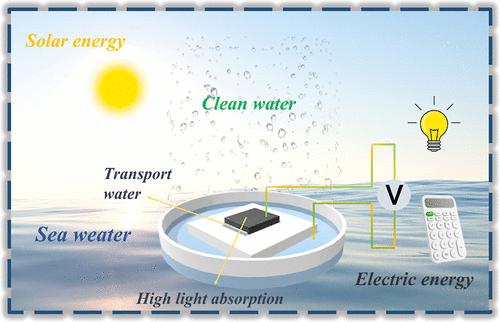基于三维分层 Cu2-xO@Cu 泡沫的太阳能驱动淡水和电力收集技术
IF 8.3
2区 材料科学
Q1 MATERIALS SCIENCE, MULTIDISCIPLINARY
引用次数: 0
摘要
将太阳能蒸汽发电与水伏特效应相结合,是同时解决水资源短缺和能源危机的一种可行策略。然而,如何在单一装置中实现高水蒸发率和高电力输出仍是一项挑战。在此,我们报告了一种三维(3D)分层 Cu2-xO@Cu 泡沫,用于在太阳能驱动下高效收集淡水和电力。通过化学蚀刻法合成的三维 Cu2-xO@Cu 泡沫具有粗糙的表面和多孔结构,使其具有亲水性表面、高光吸收性能和优异的光热效应。对于去离子水,蒸发率高达 3.03 kg m-2 h-1;同时,在 1 太阳光照射下,输出电压为 0.37 V。对于真正的海水,蒸发率降至约 2.48 kg m-2 h-1,输出电压增至 0.41 V,最大输出功率密度为 9.47 μW cm-2。水蒸发和发电性能都非常具有竞争力。室外实验证明,三维分层 Cu2-xO@Cu 泡沫可以淡化海水,同时持续发电。本文章由计算机程序翻译,如有差异,请以英文原文为准。

Solar-Driven Harvesting of Freshwater and Electricity Based on Three-Dimensional Hierarchical Cu2–xO@Cu Foam
The integration of solar steam generation and the hydrovoltaic effect is a promising strategy for simultaneously solving water scarcity and energy crises. However, it is still a challenge to attain a high water evaporation rate and a strong output of electricity in a single device. Here, we report a three-dimensional (3D) hierarchical Cu2–xO@Cu foam for solar-driven harvesting of freshwater and electricity efficiently. The 3D Cu2–xO@Cu foam synthesized by chemical etching shows a rough surface and porous structure, making it have a hydrophilic surface, high light absorption performance, and excellent photothermal effect. For deionized water, the evaporation rate is as high as 3.03 kg m–2 h–1; meanwhile, the output voltage is 0.37 V under 1 solar irradiation. For real seawater, the evaporation rate decreases to about 2.48 kg m–2 h–1, the output voltage increases to 0.41 V, and the maximum output power density is 9.47 μW cm–2. Both the water evaporation and power generation performance are very competitive. Outdoor experiments demonstrate that the 3D hierarchical Cu2–xO@Cu foam can desalinate seawater, while generating electricity continuously.
求助全文
通过发布文献求助,成功后即可免费获取论文全文。
去求助
来源期刊

ACS Applied Materials & Interfaces
工程技术-材料科学:综合
CiteScore
16.00
自引率
6.30%
发文量
4978
审稿时长
1.8 months
期刊介绍:
ACS Applied Materials & Interfaces is a leading interdisciplinary journal that brings together chemists, engineers, physicists, and biologists to explore the development and utilization of newly-discovered materials and interfacial processes for specific applications. Our journal has experienced remarkable growth since its establishment in 2009, both in terms of the number of articles published and the impact of the research showcased. We are proud to foster a truly global community, with the majority of published articles originating from outside the United States, reflecting the rapid growth of applied research worldwide.
 求助内容:
求助内容: 应助结果提醒方式:
应助结果提醒方式:


